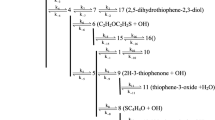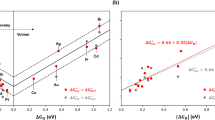Abstract
THE unsaturated aromatic ketones undergo irreversible reduction at the dropping mercury electrode to give different products in acid and in alkaline media respectively. In the acid medium the reduction product is a dimeric alcohol, the formation of which may proceed through an intermediate free radical by the following mechanism:  The half-wave potential (E
1/2) for the process is therefore associated with the addition of an electron and a proton to the oxygen atom, and according to the view advocated by us1,2 the half-wave potential may be related to the O-localization energy. In order to test this hypothesis the O-localization energies, L(−β), of benzaldehyde, benzophenone and dibenzalacetone have been calculated by the conventional molecular orbital method (taking the Coulomb integral for oxygen as αc + 2β and for the carbon atom attached to oxygen as αc + 0.1 β, where αc is the Coulomb integral for aromatic carbon and β is the resonance integral for the C—C bond) and are given in Table 1 along with the appropriate values for E
1/2. It is evident from Table 1 that as the localization energy increases, the half-wave potential also increases. In the case of acetophenone and benzalacetone, the presence of an electron-donating methyl group at the α-position with respect to the C=O group will increase the electron density at the bond, and consequently the energy necessary to add an electron to the oxygen atom in acetophenone will be greater than in benzaldehyde. In fact, in the acid region, the half-wave potential of acetophenone is higher than that of the benzaldehyde. The localization energy for acetophenone could be calculated by the molecular orbital method taking into consideration the hyperconjugation effect of the methyl group, but the calculation is so involved that it was not considered worth the trouble.
The half-wave potential (E
1/2) for the process is therefore associated with the addition of an electron and a proton to the oxygen atom, and according to the view advocated by us1,2 the half-wave potential may be related to the O-localization energy. In order to test this hypothesis the O-localization energies, L(−β), of benzaldehyde, benzophenone and dibenzalacetone have been calculated by the conventional molecular orbital method (taking the Coulomb integral for oxygen as αc + 2β and for the carbon atom attached to oxygen as αc + 0.1 β, where αc is the Coulomb integral for aromatic carbon and β is the resonance integral for the C—C bond) and are given in Table 1 along with the appropriate values for E
1/2. It is evident from Table 1 that as the localization energy increases, the half-wave potential also increases. In the case of acetophenone and benzalacetone, the presence of an electron-donating methyl group at the α-position with respect to the C=O group will increase the electron density at the bond, and consequently the energy necessary to add an electron to the oxygen atom in acetophenone will be greater than in benzaldehyde. In fact, in the acid region, the half-wave potential of acetophenone is higher than that of the benzaldehyde. The localization energy for acetophenone could be calculated by the molecular orbital method taking into consideration the hyperconjugation effect of the methyl group, but the calculation is so involved that it was not considered worth the trouble.
This is a preview of subscription content, access via your institution
Access options
Subscribe to this journal
Receive 51 print issues and online access
$199.00 per year
only $3.90 per issue
Buy this article
- Purchase on Springer Link
- Instant access to full article PDF
Prices may be subject to local taxes which are calculated during checkout
Similar content being viewed by others
References
Basu and Bhattacharya, J. Chem. Phys., 25, 596 (1956).
Basu and Nag Chaudhuri, Nature, 180, 1473 (1957).
Maccoll, Nature, 163, 178 (1949).
Pasternak, Helv. Chim. Acta, 31, 753 (1948).
Author information
Authors and Affiliations
Rights and permissions
About this article
Cite this article
NAG CHAUDHURI, J., BASU, S. Half-wave Potentials of Aromatic Ketones. Nature 182, 179–180 (1958). https://doi.org/10.1038/182179a0
Issue Date:
DOI: https://doi.org/10.1038/182179a0
Comments
By submitting a comment you agree to abide by our Terms and Community Guidelines. If you find something abusive or that does not comply with our terms or guidelines please flag it as inappropriate.



